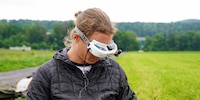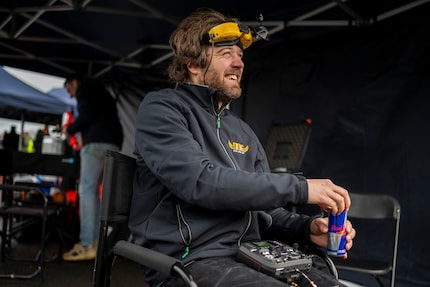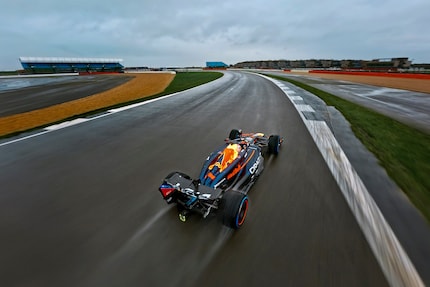
Background information
Drone the fifth - I'm finally flying, just not with my drone
by Manuel Wenk

Formula 1 action on the Silverstone race track. Drone pilot Ralph Hogenbirk uses a specially developed drone to follow a racing car driven by Max Verstappen. This gives viewers a feel for the speeds on a Formula 1 circuit.
A consumer drone, as most people know it, stays in the air for up to 45 minutes and flies at around 80 kilometres per hour. Anyone who builds their own FPV (First Person View) drone can fly through the air at speeds of up to 180 kilometres per hour.
What the team led by Dutch drone pilot Ralph Hogenbirk has now achieved has never been done before. The drone, which looks more like a rocket, has a flight time of around three minutes, sprints from 0 to 300 in four seconds and even reaches a speed of up to 350 kilometres per hour. For comparison: Formula 1 cars take around twice as long to reach the top speed of 300 kilometres per hour, as can be seen here in the video:
The team around "Shaggy FPV", as Hogenbirk is also known, spent a year developing and testing the drone. First in the simulator, then on the real race track with substitute driver Liam Lawson and 13-time Grand Prix winner David Coulthard.
The pilot controls the drone manually. He puts on video goggles that show him a live image from the drone camera and manoeuvres the aircraft with his thumbs using a controller. A few years ago, I experienced for myself just how difficult this is.
Many pilots today rely on a digital system, such as those manufactured by DJI. These systems send the video signal from the drone to the goggles. However, digital solutions have a slight delay of around 30 milliseconds. Too much for an aircraft that follows a racing car at 350 km/h. The latency of an analogue system is much lower. Disadvantage: The picture quality resembles an anthill (as with tube televisions in the past) and makes it even more difficult for the pilot. As can be seen in the video, Hogenbirk still relies on an analogue system.

After hours of training, the big day for drivers and racing drivers arrived on 13 February. This time, three-time world champion Max Verstappen is in the Cockpit. The rain has soaked the track. The driver only has one attempt to film the RB20 racing car that has just been unveiled.
Racing driver Verstappen says about the project: "I never thought I would ever see a drone that is so fast just to take footage. I was really surprised at how fast it was and how close it got to me in the corners. It gives Formula 1 a whole new perspective."
The video gives the audience a sense of what it must feel like to be behind the wheel of a racing car. The landscape rushes by on long straights. Hogenbirk on the unique project: "No camera drone in the world is as fast as ours. This is a unique prototype. I've never done anything this crazy before."

The project was supported by RedBull and Hagenbrik has already made a name for himself with a drone bike video in Chile. For Red Bull, the project is another very successful marketing coup alongside jumps from space and other crazy things. The video was clicked on several million times after just a few hours.
However, nobody has ever flown a drone at 350 kilometres an hour. We are already familiar with spectacular images with FPV drones from downhill races. Spectators are up close and personal when Marco Odermatt and co. plummet down the Lauberhorn. It will probably be a while before drones are used in Formula 1. What exactly happens on the race track is less predictable than in ski races. A mistake by the drone pilot would have far-reaching consequences here.
Would you be happy to see such spectacular images on TV soon?
As a Multimedia Producer, preparing multimedia content and knowing about cutting-edge technology is my business. My main focus at digitec is producing videos. I can’t wait to try out new products such as cameras, drones or smartphones as soon as they’re launched. This is where being at the source comes in rather handy. When I’m not working, I’m probably skiing, biking or hiking – the mountains are my place to be.
From the latest iPhone to the return of 80s fashion. The editorial team will help you make sense of it all.
Show all